Bourbon-soaked peaches blend traditional Southern preservation with rich flavors dating back to colonial America. You'll need ripe freestone peaches, quality bourbon (90-100 proof), and basic canning supplies. Start by blanching and peeling the peaches, then prepare a bourbon syrup mixture. Pack the peaches in sterilized Mason jars, cover with the bourbon mixture, and process in a water bath canner for 25-30 minutes. When properly sealed and stored, your bourbon-soaked peaches will last up to three years, though they're best enjoyed within the first year. The perfect balance of sweetness and bourbon creates endless serving possibilities that you'll want to explore.
History of Southern Peach Preservation
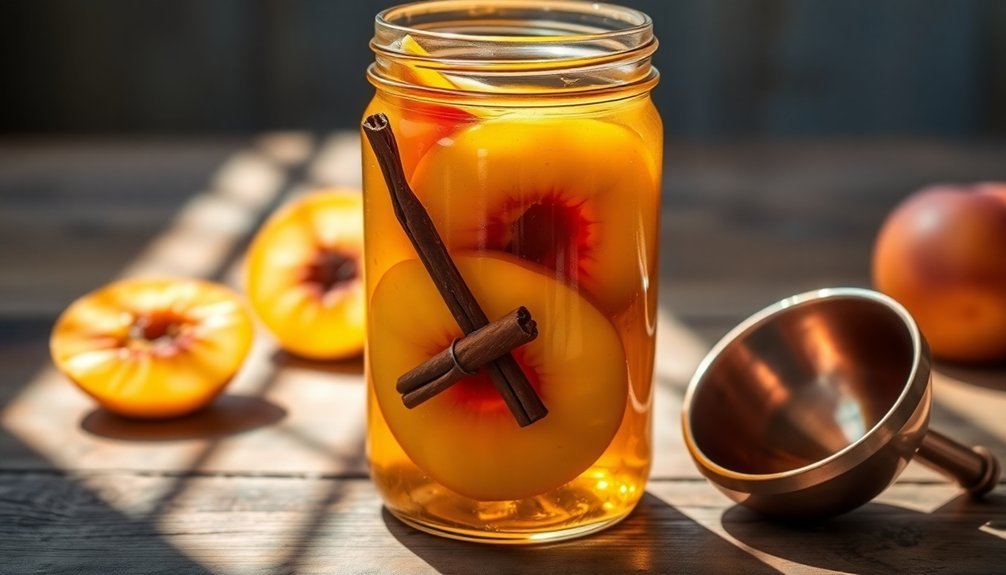
The journey of peaches to the American South began in the mid-sixteenth century, when Spanish colonists first brought these fruit-bearing trees across the Atlantic.
You'll find that these peaches had already traveled an impressive route from China through the Silk Road, passing through Rome and Persia before reaching Western Europe and eventually the Americas.
By the time European settlers established Jamestown, you'd have discovered peach trees already thriving in the region, thanks to Indigenous tribes who'd embraced and adapted the fruit.
These tribes created extensive orchards, contributing notably to the peaches' genetic diversity in North America. The most significant archaeological evidence shows ancient peach pits discovered in China's Yangtze River Valley.
You would've seen peaches become deeply integrated into Southern life, particularly in plantation agriculture.
They grew abundantly in sandy fields that couldn't support other crops, and you'd have found them used for everything from syrups to brandies.
These orchards served multiple purposes – they provided sustenance, created valuable products like South Carolina's prized peach brandy, and even offered refuge for escaped slaves.
Preservation became essential, and Southerners developed various methods to keep peaches year-round, including traditional canning techniques using both raw and hot pack methods.
Selecting Perfect Peaches
Selecting perfect peaches requires attention to multiple characteristics that signal peak ripeness and quality. You'll want to look for fruits with a dark yellow or cream background color, avoiding any that show traces of green. While a red blush might look attractive, it's not actually an indicator of ripeness.
When you're testing for ripeness, gently press the peach – it should yield slightly to pressure without being mushy. You'll need to be careful not to squeeze too hard, as this can cause bruising. A ripe peach will also reward you with a sweet, distinctive aroma, which is one of the most reliable indicators of good flavor. For optimal preservation results, consider using freestone varieties, as their flesh separates easily from the pit during processing.
| Characteristic | Good Signs | Warning Signs |
|---|---|---|
| Color | Dark yellow/cream background | Green patches |
| Texture | Slight give when pressed | Too firm or mushy |
| Aroma | Sweet, peachy smell | No smell |
| Shape | Round, full size | Small, misshapen |
For the best bourbon-soaking results, you'll want peaches with a brix level above 12, which indicates ideal sweetness. Look for fruits that are free from blemishes and have reached their full size, as these will provide the best flavor and texture for preservation.
Essential Tools and Equipment
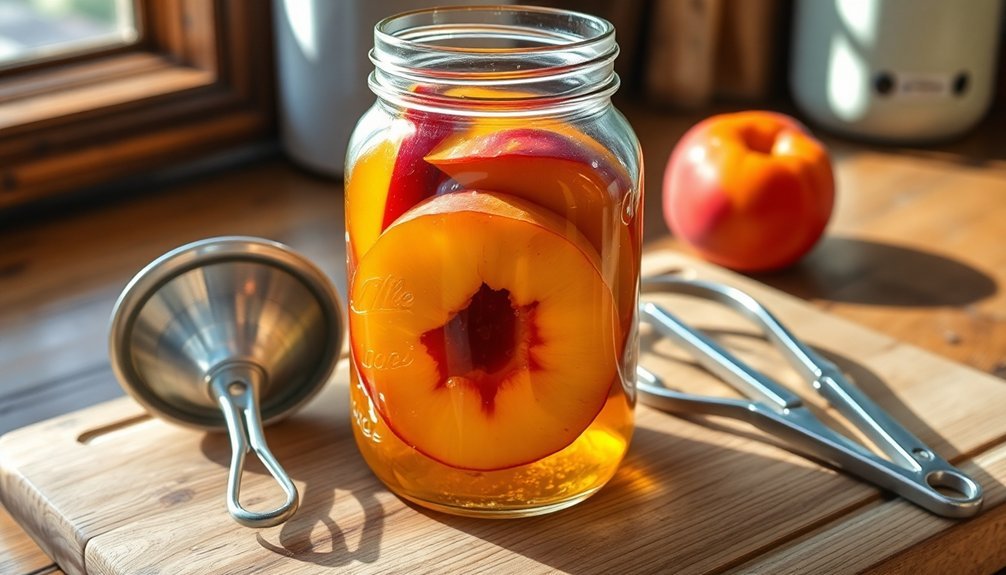
Successfully preparing bourbon-soaked peaches requires a well-equipped kitchen with specific tools for canning, measuring, and handling.
You'll need basic canning equipment, including Mason jars in either pint or quart sizes, accompanied by matching lids and rings. A water bath canner or large pot with a rack is vital for proper preservation.
For the cooking process, you'll want to have two saucepans: a large one for the bourbon syrup and a medium one for blanching peaches. You'll also need a sharp paring knife for scoring peaches and an ice bath container for quick cooling.
Don't forget your measuring cups and spoons for precise bourbon and syrup measurements. Following USDA canning guidelines is crucial for safe food preservation. To guarantee food safety, you'll need sterilization equipment for your jars and tools, plus clean dish towels for wiping jar rims.
A jar lifter is essential for safely handling hot containers, while a funnel helps prevent spills when filling jars. You'll also need a plastic knife or bubble remover to release trapped air.
For cooling, make sure you have a rack where your filled jars can rest undisturbed. A spatula and large spoon or ladle will help you manage the hot peaches and syrup during the filling process.
Choosing Your Bourbon
When you're selecting bourbon for peach infusion, you'll want to choose a quality mid-priced option with at least 80 proof, such as Four Roses, Buffalo Trace, or Knob Creek.
The bourbon's flavor profile should complement the peaches with balanced sweetness and spice notes, while maintaining a smooth finish that won't overpower the fruit.
Your chosen bourbon should be rich and full-bodied enough to enhance the infusion, yet not so complex that it masks the natural peach flavors.
Quality Bourbon Selection Tips
The perfect bourbon for your peach recipe starts with understanding four essential qualities: proof, age, mash bill, and distillery reputation.
For bourbon-soaked peaches, you'll want to select a bourbon that's between 80-90 proof, as higher proofs can overwhelm the fruit's natural sweetness while still delivering robust flavor.
Look for straight bourbon aged at least two years, though you don't need to splurge on extensively aged varieties since you'll be infusing it with fruit. The age statement on the bottle will tell you the minimum aging time of the youngest whiskey in the blend.
When examining mash bills, consider wheated bourbons, which substitute wheat for rye in the recipe. These offer mellower, sweeter notes that complement peaches beautifully.
Choose a reputable distillery that follows traditional bourbon-making methods. You'll want a quality bourbon that meets all legal requirements: made in the USA, containing at least 51% corn, and aged in new charred American oak barrels.
Bourbon Flavor Profiles Explained
Understanding bourbon flavor profiles helps you make an informed choice for your peach-soaking adventure. When selecting your bourbon, you'll want to evaluate the core flavor components that will complement your peaches. Sweet and fruity notes like caramel, vanilla, and honey work particularly well, as they'll enhance the natural sweetness of the fruit.
You'll find that bourbon's flavor complexity comes from multiple sources. The mash bill, particularly the corn content, contributes natural sweetness, while rye adds spicy notes like cinnamon and pepper. Oak barrel aging imparts woody characteristics and vanilla undertones, which can range from subtle to pronounced depending on the aging duration.
For peach soaking, you'll want to focus on bourbons that feature prominent fruit-forward profiles with complementary sweet notes. Look for bottles that highlight flavors like apple, pear, or cherry, accompanied by caramel or vanilla backgrounds.
Avoid heavily spiced or high-rye bourbons, as these might overwhelm your peaches' delicate flavor. Remember that younger bourbons tend to be fruitier and sweeter, making them ideal candidates for fruit preservation, while older varieties can introduce more complex woody notes.
Proof Level Considerations
Success in bourbon-soaked peaches hinges heavily on selecting the right proof level for your infusion.
You'll want to use bourbon that's at least 80 proof (40% ABV), as this guarantees proper flavor extraction from your peaches while maintaining the spirit's preservative qualities.
While higher-proof options are available, you don't necessarily need the highest proof bourbon for successful infusion.
When selecting your bourbon, you'll find options ranging from the minimum 80 proof up to barrel-proof expressions that can exceed 140 proof.
For peach infusions, you'll typically want to stay in the middle range – around 90 to 100 proof is ideal. At this level, you'll get excellent flavor transfer without overwhelming the delicate peach notes.
If you're using a higher-proof bourbon, you might need to adjust your infusion time to prevent the alcohol from overpowering the fruit's natural sweetness.
Remember that consistency is key for predictable results.
Once you've found a proof level that works well with your recipe, stick with it. This helps you maintain control over your infusion's flavor profile and guarantees reliable preservation of your peaches.
Preparing Fresh Peaches
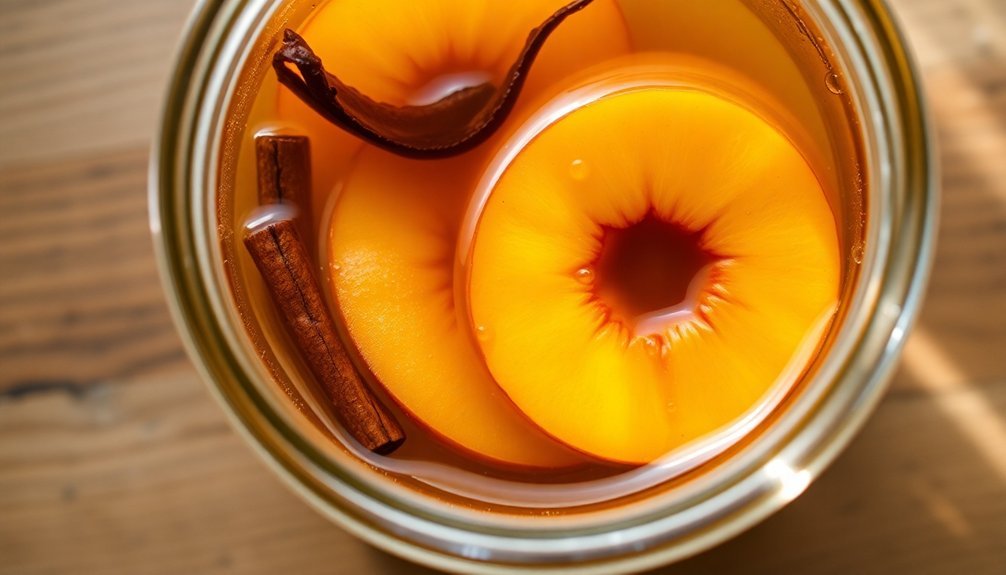
Properly preparing fresh peaches forms the foundation for delicious bourbon-soaked treats. You'll want to start by selecting peaches that have a yellow or cream background color and feel soft to the touch. Don't be fooled by the red blush, as it's not an indicator of ripeness. Your chosen peaches should be free from blemishes and emit a fresh, peachy fragrance.
To prepare your peaches, you'll need to peel and slice them carefully. Begin by dipping the fruits in boiling water for 30-60 seconds, followed by an immediate cold water bath to easily slip off the skins. Cut the peaches in half, remove the pits, and slice them according to your recipe's specifications.
To maintain the peaches' appealing color throughout the preparation process:
- Create an ascorbic acid solution using 2½ teaspoons of crystals per cup of water
- Keep peeled peaches in this solution during preparation
- Use a silicone spatula to handle soft peaches, preventing unnecessary bruising
If your peaches are still firm, place them in a loosely closed brown paper bag at room temperature for 2-3 days until they reach the desired ripeness.
Sterilizing Jars and Lids
Before you begin soaking peaches in bourbon, sterilizing your canning jars and preparing the lids correctly will guarantee both safety and success.
You'll need to start by washing your jars thoroughly with hot, soapy water and rinsing them well.
You've got two effective options for sterilization. You can place the clean jars in your oven at 275 degrees for 10 minutes, or submerge them in a water bath canner with water one inch above the jar tops and boil for 10 minutes.
If you're at a higher elevation, add an extra minute of boiling time for each 1,000 feet above 1,000 feet.
Don't sterilize your canning lids – this is an outdated practice that's no longer recommended by manufacturers. Instead, keep them at room temperature until you're ready to use them.
While your jars are sterilizing, check their rims for any debris or damage that could prevent a proper seal.
Keep your sterilized jars warm until you're ready to fill them with your bourbon-soaked peaches. This prevents thermal shock and potential breakage when you add the hot contents to the jars.
Making the Sugar Syrup
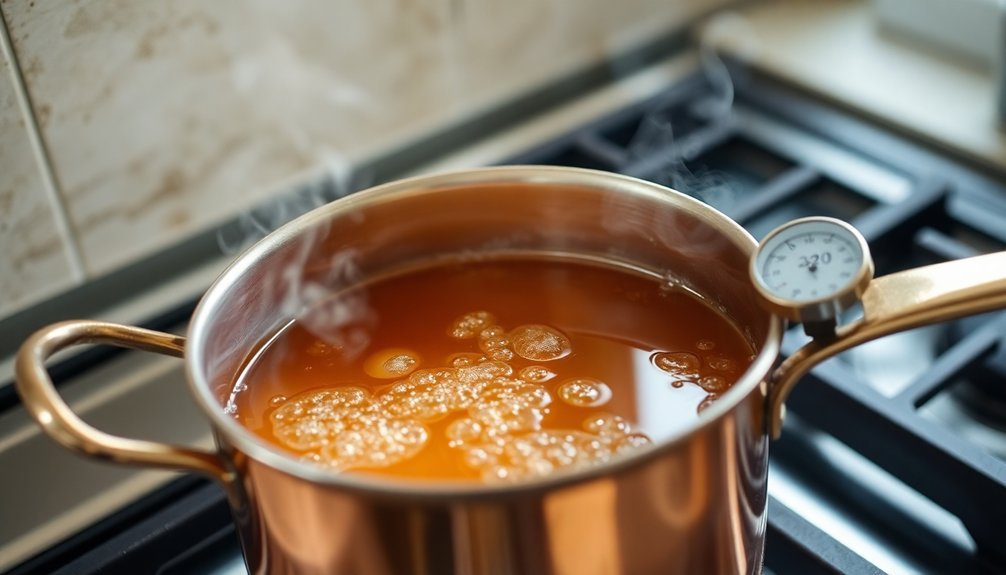
Creating the sugar syrup is a critical step that determines both the sweetness and preservation quality of your bourbon-soaked peaches.
You'll need to decide between a heavy or light syrup based on your taste preferences. For maximum preservation and sweetness, combine 7 cups each of water and sugar. If you prefer a lighter option with fewer calories, use 2 cups of water to 1 cup of sugar instead.
To prepare the syrup, combine your chosen ratio of water and sugar in a separate pot. Stir frequently as you bring the mixture to a boil, making sure the sugar dissolves completely.
You can customize your syrup by replacing up to half the granulated sugar with light corn syrup or mild-flavored honey.
When adding the syrup to your jars of sliced peaches:
- Pour the hot syrup while leaving 1-inch headspace at the top
- Use a wooden skewer or chopstick to remove air bubbles
- Make certain the syrup completely covers the peaches for proper preservation
After you've added the syrup, you're ready to incorporate the bourbon, which will infuse your preserved peaches with that distinctive Southern flavor.
Packing Methods for Best Results
Successful peach preservation starts with proper packing techniques that guarantee both safety and quality. You'll need to pack your peaches tightly into clean jars, making certain there's sufficient space at the top – 1 inch for quarts and ½ inch for pints. This headspace is essential for proper sealing and preservation.
Begin by blanching your peaches in boiling water for 30-60 seconds, then quickly transfer them to cold water. The skins will slip off easily, allowing you to cut them into halves or slices. Choose firm, slightly under-ripe freestone peaches for the best results, as they're easier to work with and maintain their shape better during processing.
As you pack the jars, use a rubber spatula to remove any air bubbles trapped along the sides. Make certain your peaches are completely covered by the syrup, and if needed, add a small piece of crumpled water-resistant paper to keep the fruit submerged.
Before sealing, wipe the jar rims clean with a dish towel to guarantee a proper seal. You'll want to tighten the lids to finger-tight only – overtightening can prevent proper sealing during processing.
Adding Bourbon and Seasonings
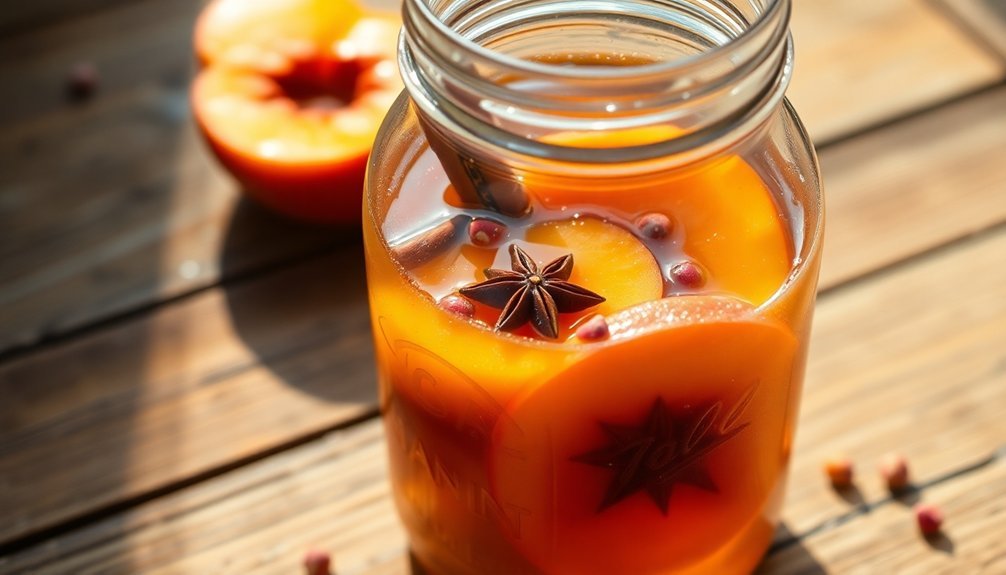
With your peaches packed securely in jars, it's time to add the bourbon and seasonings that'll transform them into a sophisticated preserve. Pour 2-4 tablespoons of bourbon directly into each jar, using less for pints and more for quarts. You can substitute brandy or rum if you prefer, adjusting the amount to match your taste.
While your sugar syrup simmers on the stovetop, you'll want to incorporate additional flavors that complement both the peaches and bourbon. Create a rich poaching liquid by adding vanilla extract or fresh vanilla pods to your syrup, and don't forget a splash of lemon juice to prevent browning.
- Add a slice of fresh orange to each jar for a bright, citrusy note
- Include a cinnamon stick to create warm, spicy undertones
- Drop in a split vanilla bean to infuse the syrup with intense flavor
Let the mixture simmer for 15-20 minutes until it reduces to a thick, syrupy consistency. You'll notice the liquid becoming more concentrated as it cooks down.
Pour the hot syrup over your peaches, making sure to cover them completely. This reduction process helps the bourbon and seasonings penetrate the fruit more effectively.
Water Bath Processing Steps
You'll need to sterilize your quart-sized canning jars in boiling water for 10 minutes if you're below 1,000 feet elevation, adding an extra minute for each additional 1,000 feet.
Once you've loaded your bourbon-soaked peaches into the jars, place them in your water bath canner with at least 1 inch of water covering the tops, ensuring they're sitting on a rack and spaced 1/2 inch apart.
When the water reaches a rolling boil, start your timer for the full processing duration of 20-30 minutes, maintaining a gentle but steady boil throughout.
Timing for Safe Processing
Proper timing is critical when processing bourbon-soaked peaches in a water bath canner. You'll need to process pint jars for 25 minutes and quart jars for 30 minutes if you're at elevations below 1,000 feet.
Don't be tempted to cut corners – shorter processing times won't effectively kill harmful bacteria and molds that can cause spoilage.
If you're canning at higher elevations, you'll need to adjust your processing time accordingly. Remember that proper heat penetration is essential for food safety, especially when working with peaches. While peaches are naturally acidic, they still require sufficient heating time to guarantee safe preservation.
- Process pint jars for 25 minutes and quart jars for 30 minutes at elevations below 1,000 feet
- Maintain water level at least 1 inch above jar tops throughout processing
- Allow jars to sit in the canner for 5 additional minutes after processing before removal
After processing, you'll need to let your jars cool completely on a wire rack.
Don't skip this step – proper cooling guarantees a strong seal and prevents moisture from accumulating under your lids. Once cooled, store your bourbon-soaked peaches in a cool, dark place.
Equipment Setup Guidelines
| Equipment | Preparation | Purpose |
|---|---|---|
| Jars & Lids | Wash, sterilize 10 min | Guarantee safe preservation |
| Canner/Pot | Fill with hot water | Process sealed jars |
| Rack | Place in canner bottom | Prevent jar breakage |
| Utensils | Clean and sanitize | Safe food handling |
When you're ready to fill jars, maintain proper headspace and remove air bubbles using a rubber spatula. Wipe jar rims clean, then secure lids and rings until finger-tight. Use your jar lifter to carefully place filled jars into the hot water bath.
Cooling and Testing Seals
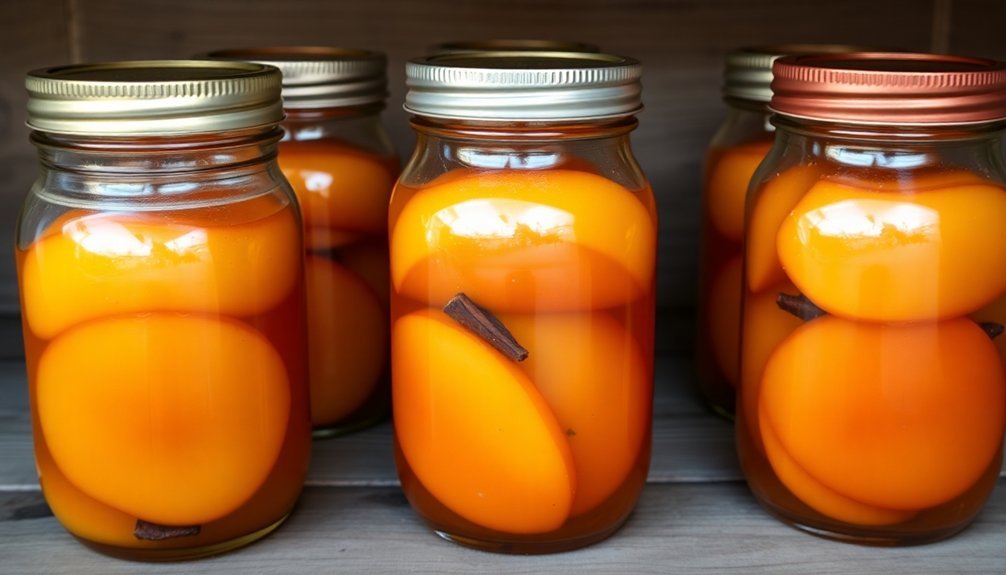
After the peaches have been processed, cooling them correctly and testing the jar seals are critical steps for food safety. Transfer your peaches immediately to an ice water bath to halt the cooking process, ensuring they maintain their ideal texture – tender yet firm.
While the peaches cool, reduce your bourbon syrup over medium heat for 15-20 minutes until it reaches the desired consistency, then strain out any sediment.
To prevent browning during cooling, you'll want to keep your peeled peaches in an ascorbic acid solution. Once everything's cooled to room temperature, fill your sterilized jars with the peach and syrup mixture, leaving proper headspace for sealing.
- Check seals by pressing the lid center – it shouldn't flex or make a popping sound
- Let jars cool undisturbed for 12-24 hours after processing
- Store sealed jars in a cool, dark place for ideal preservation
Don't forget to monitor your seals periodically for any signs of leakage or spoilage.
Label each jar with the date and contents, and if you haven't processed them for canning, store them in the refrigerator to maintain freshness longer.
Storage Tips and Guidelines
Long-term success with your bourbon-soaked peaches depends on smart storage practices. While your bourbon-soaked peaches can last up to three years, you'll want to consume them within the first year for the best quality and flavor. After one year, you might notice some color loss and breakdown in the fruit's texture.
Store your jars in a cool, dark location away from direct sunlight and high temperatures. Keep them upright to prevent any leakage, and make sure your storage area stays clean and free from pests. You'll also want to protect the jars from moisture to avoid rust formation on the lids or bands.
When you're arranging your storage space, remember to place newer batches behind older ones, so you'll use the oldest jars first. Check your jars periodically for any signs of spoilage, such as bulging lids, leakage, or unusual discoloration.
If you notice any jars with broken seals or signs of contamination, discard them immediately. While the bourbon acts as a preservative, proper storage is still essential for maintaining both safety and quality throughout the preservation period.
Serving and Pairing Suggestions
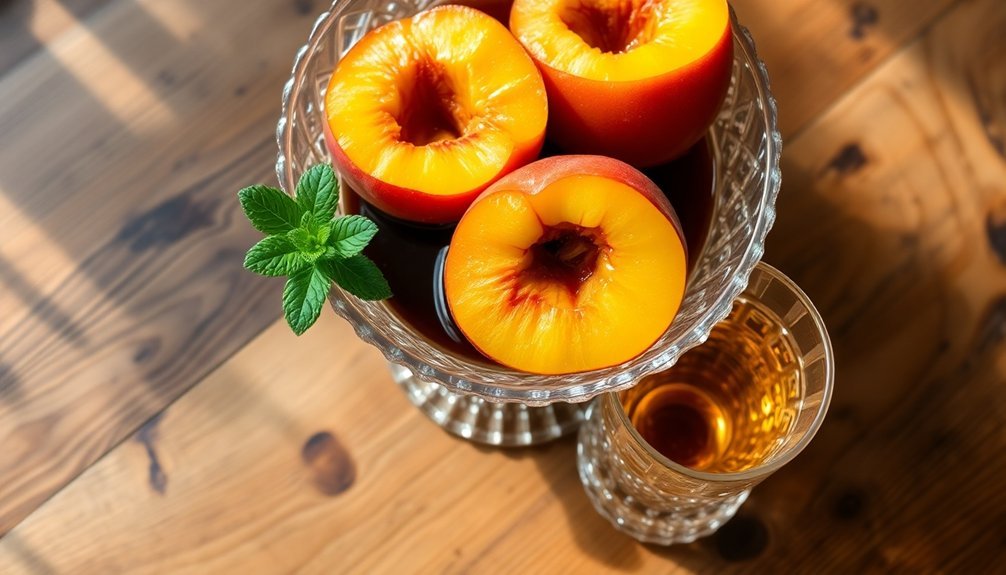
Once your bourbon-soaked peaches are properly stored, you'll want to explore the many ways to serve and enjoy them. Serve them warm with the original poaching sauce, or elevate the experience by adding a scoop of vanilla ice cream and fresh mint garnish. For added richness, pair them with whipped cream or incorporate them into your morning yogurt or oatmeal.
These versatile bourbon-infused fruits can transform ordinary desserts into sophisticated treats. You'll find they're especially delightful when:
- Combined with other fruits like strawberries and blueberries for a boozy fruit salad
- Used as a decadent topping for cheesecakes, crème brûlée, or chocolate desserts
- Incorporated into cocktails, smoothies, or bourbon-infused beverages
For social gatherings, bourbon-soaked peaches make an impressive addition to your menu. They're perfect for dinner parties, summer BBQs, and outdoor picnics.
You can serve them individually or in a large serving dish as part of a dessert spread. They're particularly fitting when paired with other Southern-inspired desserts for a themed event, offering your guests a unique taste of traditional preservation methods with a modern twist.
Frequently Asked Questions
Can I Reuse the Bourbon-Soaked Peaches Liquid for a Second Batch?
You shouldn't reuse the bourbon liquid for a second batch. It's lost significant flavor and potency during the first infusion, and there's a higher contamination risk. You'll get better results using fresh bourbon.
Will the Alcohol Content Remain After Processing the Bourbon Peaches?
If you're canning the peaches, the alcohol will evaporate during processing. However, if you're just soaking them without heat processing, you'll retain up to 85% of the alcohol content in your peaches.
Can I Substitute Other Stone Fruits for Peaches in This Recipe?
Yes, you can substitute Greengage plums, apricots, or wild cherries for the peaches. Each stone fruit brings its own unique flavor profile, so you'll want to adjust sugar levels based on natural sweetness.
How Do You Prevent the Peaches From Floating to the Top?
To prevent floating, pack your peaches tightly cut-side down, use light syrup instead of heavy, remove all air bubbles, and guarantee you're using perfectly ripe fruit. Don't overprocess, as this damages cell structure.
What Signs Indicate the Preserved Peaches Have Gone Bad?
You'll know your preserved peaches have gone bad if you spot mold, detect sour or musty odors, notice slimy textures, see cloudy syrup, or find the fruit's become overly soft and discolored.
In Summary
You'll find these bourbon-soaked peaches are more than just a delicious treat – they're a piece of Southern heritage. Store your jars in a cool, dark place for up to a year, and you'll have summer's sweetness whenever you need it. Serve them over vanilla ice cream, pound cake, or straight from the jar. Once you've mastered this preservation technique, you'll treasure it for years to come.

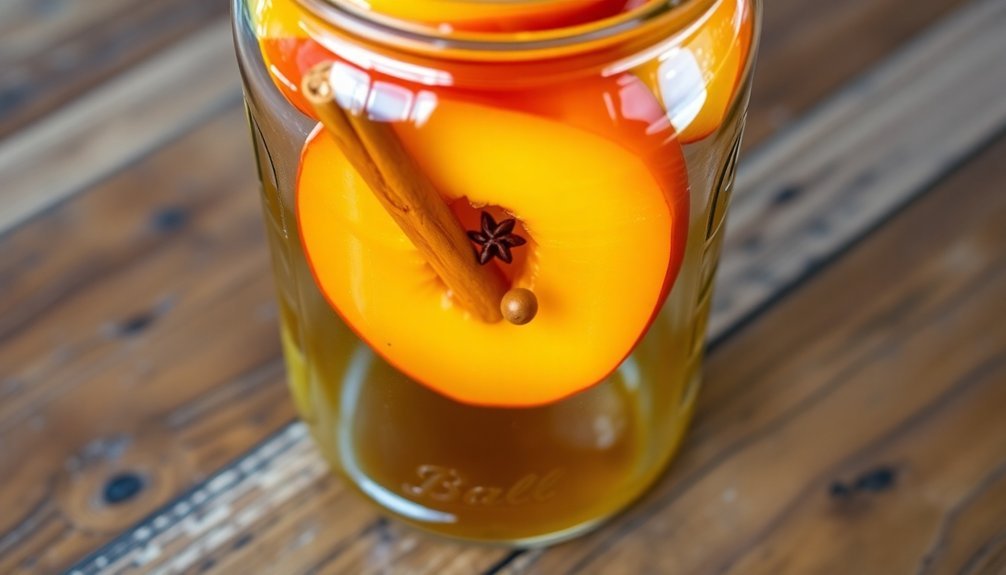



Leave a Reply